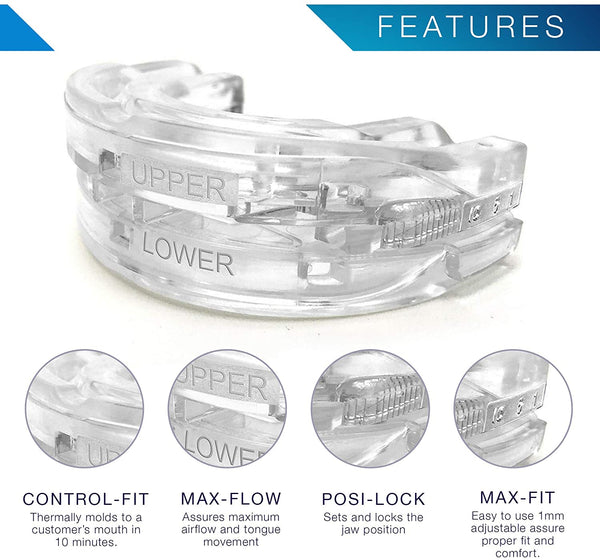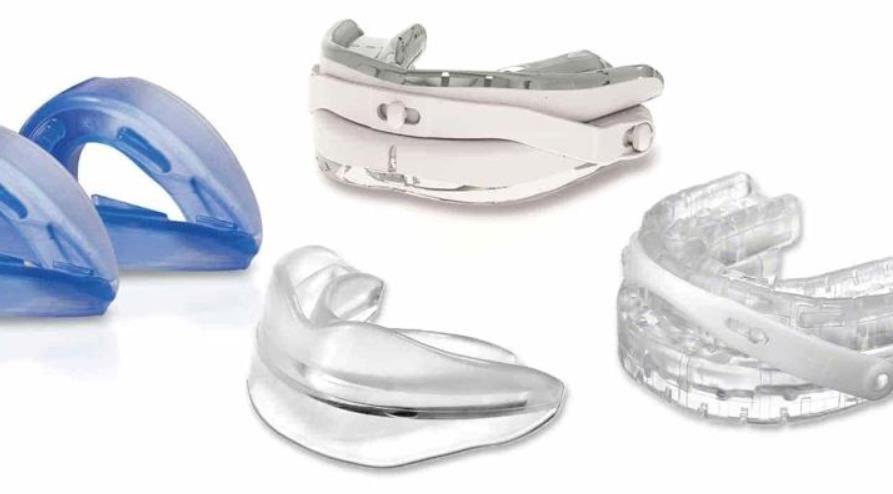Outline:
1 Mandibular Advancement Device (MAD):
Moving the jaw forward helps prevent airway obstruction in two ways:
Boil bite mouthguard for sleep apnea
Custom/dental mouthpieces for sleep apnea
2 Tongue Retention Device (TRD)
Sleeping with a tongue retainer can reduce the risk of sleep apnea by
3 Day and night appliance (or DNA appliance)
4 Which types you can use?
There are 3 types of sleep apnea mouth guards:
Mandibular Advancement Device (MAD):
MAD works by temporarily moving the jaw forward to improve airway space.
A mandibular advancement device, also known as a mandibular reduction device (MRD) and a mandibular advancement splint (MAS), is a plastic mouthguard that covers the upper and lower teeth. The word mandible refers to the lower jaw. It moves your jaw forward a few millimeters or more, which helps open the airway.
They are currently the most popular choice for individuals opting for this type of treatment. This form of sleep apnea mouth guards therapy utilizes the structure of the jaw itself to minimize the risk of airway obstruction.
Moving the jaw forward helps prevent airway obstruction in two ways:
Creates muscle tension: Positioning the jaw with the MAD creates slight tension in the muscles that make up the tongue and throat. This reduces the risk of these muscles relaxing enough to collapse into the airway.
Opening the airway: Placing the chin in a forward position also opens the airway further. This creates extra space in the throat and airways, making them less susceptible to blockage.
These adjustments make it easier for air to flow into the lungs and reduce the chance of a complete blockage. As a result, your snoring may decrease, the number of sleep disturbances may improve, and ultimately improve your quality of life.
The MAD can be a one-piece or two-piece device. One-piece options are stiffer, hold the upper and lower jaws in place, and don't allow the mouth to move like a two-piece, which some find limiting; a two-piece has two separate components joined together.

Boil bite mouthguard for sleep apnea
Similar to regular mouthguards, boil-and-bite sleep apnea mouthguards are available at most drugstores and are relatively inexpensive. Boil mouthguards come in one size so you can customize them to fit your teeth. This involves boiling the mouthguard until softened, then placing it over the front teeth and biting down. For the best fit, be sure to follow the included instructions.

Custom/dental mouthpieces for sleep apnea
They will take a mold of your teeth and use it to create a mouthguard that is tailored to your teeth and the structure of your mouth. This provides a better fit than regular mouthguards or boil mouthguards, which makes them more comfortable and less likely to accidentally come off while you sleep. If you grind your teeth, snore, or suffer from sleep apnea, a custom mouthguard is your best choice. While they are more expensive than over-the-counter mouthguards, many dental insurance plans cover some or all of the cost.
Whether you're interested in an over-the-counter device or a custom mouthguard, it's important to work with your doctor when seeking treatment for MAD.
Tongue Retention Device (TRD):
The TRD works by holding the tongue forward to prevent snoring and sleep apnea symptoms caused by a large tongue.
Tongue anchors use suction to hold the tongue in a forward position so it doesn't collapse back into the airway.
TSDs are usually shaped like a pacifier, with an appendage that holds the tongue in a forward position. They consist of a tongue guard surrounded by a mouthpiece, which sits between the lips and teeth. Then place the tongue into the sleeve and use gentle suction to hold it in place. Some people think that TRD is not as comfortable as MAD.
These devices are a great solution for people who suffer from snoring or sleep apnea caused by their tongue falling into the back of their throat while sleeping. TRDs are available to people who do not have enough teeth to hold the MAD in place or who cannot use the MAD for other reasons.
TRDs haven't been studied as well as MADs, so it's unclear how well they work in treating OSA. Therefore, they are not prescribed or used very often.
Sleeping with a tongue retainer can reduce the risk of sleep apnea by:
Holds your tongue in place: When you sleep on your back, your tongue relaxes into your throat due to gravity. When this occurs in combination with other structural changes, OSA may be triggered. Tongue stabilizers physically hold the tongue in place so it stays flat in the mouth instead of bunching up and/or relaxing into the back of the throat.
Muscles that control the tongue: Sticking the tongue out too much can cause excessive tension in the tongue muscles. This can actually cause the tongue to pucker so that it partially blocks the airway. Also, over-relaxation can lead to blockage. Tongue stabilizers not only hold the tongue in place, but also prevent it from becoming too tense or too relaxed.
Preventing the tongue from falling into the back of the throat addresses one of the biggest triggers of obstructive sleep apnea. After using a tongue stabilizer, you may snore less and have fewer breathing problems while you sleep.
Day and night appliance (or DNA appliance)

This FDA-cleared dental appliance is a non-surgical method of gradually widening the dental arch. It works by giving the tongue room in the mouth, which is a common cause of airflow obstruction during sleep.
DNA appliance gently expand the upper arch space in three dimensions, thereby increasing the size of the nasal cavity. As the upper arch widens, the lower jaw is able to move forward into a more natural position. As the jaw moves forward, it pulls on the tongue and soft tissues, increasing the size of the airway. The result is a significant improvement in the patient's ability to breathe.
Which types you can use?
Which mouth guard is suitable for you, please consult your dentist to get the best solution.

